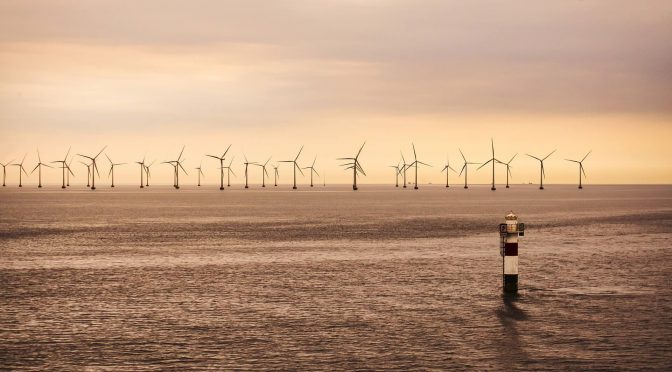Virginia’s first offshore wind energy project began construction Monday morning at an unexpected place: onshore.
Eventually, two massive turbines will be erected by Danish company Ørsted Energy 27 miles off the coast of Virginia Beach as part of Dominion Energy’s Coastal Virginia Offshore Wind Project. But the July 1 groundbreaking for the project focused on a more humble — and terrestrial — phase of the effort: the installation of a half-mile-long conduit needed to bring the energy generated by those turbines to the company’s Birdneck Substation, which sits near Camp Pendleton.
A pilot for a potentially much larger project, the CVOW is expected to generate 12 megawatts of energy, enough to power roughly 3,000 homes. If it proves successful, Dominion will have the ability to expand its offshore operations to produce 2,000 megawatts of energy on the site, which is leased from the federal government.
Dominion Energy chairman, president and CEO Tom Farrell called the project “a sign of our commitment to bring more renewable energy to our customers,” while Gov. Ralph Northam praised it as “another powerful example of the Commonwealth’s position as a leader in renewable energy.”
Besides being Virginia’s first offshore wind venture, the CVOW will also be the United States’ first in federal waters, which stretch from 3 to 200 nautical miles off the nation’s coast.
Numerous Atlantic states have put forward plans to develop offshore wind, but at present the only operational facility is the Block Island Wind Farm off the coast of Rhode Island. While a portion of the Block Island cable connecting its turbines to the electric grid does run through federal waters, the turbines themselves are in waters under the jurisdiction of Rhode Island.
The CVOW is also explicitly endorsed in the commonwealth’s 2018 Energy Plan, which supports both the pilot and development of the full 2,000-megawatt buildout by 2028.
But while policymakers have largely supported the development of Virginia’s offshore wind sector, the State Corporation Commission, which is responsible for regulating the commonwealth’s utilities, has balked at the $300 million price tag attached to the CVOW’s pilot phase.
Dominion said Monday that “customers will see no increase in rates for the pilot project” and that costs will be recovered through existing base rates rather than a rider, an additional charge levied by utilities to pay for particular projects or costs.
The SCC, however, has expressed skepticism about not only the pilot’s estimated cost, but also the lack of competitive bidding involved in it and its financial implications for Dominion’s customers, who the commission found “bear all of the risk of the proposed Project, including cost overruns and lack of performance.”
While the Commission declared the CVOW a “prudent” project and issued it a certificate of public necessity and convenience in November, its order made it clear that the decision was driven by General Assembly policy directives encouraging the development of wind energy rather than the commission’s own judgment.
“As a purely factual matter based on this record,” the final order read, the project “would not be deemed prudent as that term has been applied by this Commission in its long history of public utility regulation or under any common application of the term.”
Dominion could also write off the CVOW’s costs in its earnings calculations, said SCC Division of Information Resources Director Ken Schrad, which would reduce the amount of refunds it would owe customers if it earned more than the SCC allows. (Regulators cap utilities’ earnings in exchange for allowing them a monopoly over their service territory.)
The SCC has consistently found that Dominion’s earnings have exceeded their authorized level.
While the CVOW will not lead to a direct rate increase, said Schrad, ratepayers will “absorb the full risk of the project while lessening the chance of them ever getting a refund or a base rate reduction if the company continues to receive revenues from base rates at levels that exceed the authorized return.”
Sarah Vogelsong, virginiamercury.com


